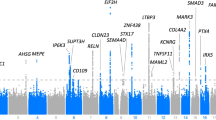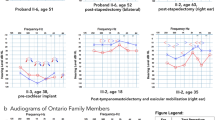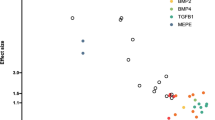Abstract
Otosclerosis is a common disorder of the otic capsule resulting in hearing impairment in 0.3–0.4% of the Caucasian population. The aetiology of the disease remains unclear. In most cases, otosclerosis can be considered as a complex disease. In some cases, the disease is inherited as an autosomal dominant trait, sometimes with reduced penetrance. To date, seven autosomal dominant loci have been reported, but none of the disease-causing genes has been identified. In this study, we present the results of a genome-wide linkage analysis in a large Tunisian family segregating autosomal dominant otosclerosis. Linkage analysis localised the responsible gene to chromosome 9p13.1-9q21.11 with a maximal LOD score of 4.13, and this locus was named OTSC8. Using newly generated short tandem repeat polymorphism markers, we mapped this new otosclerosis locus to a 34.16 Mb interval between the markers D9S970 and D9S1799. This region comprises the pericentromeric region on both arms of chromosome 9, a highly complex region containing many duplicated sequences.

Similar content being viewed by others
References
Alzoubi Q, Roller W, Ramsden RT, Saeed SR (2007) No evidence of linkage between 7q33–36 locus (OTSC2) and otosclerosis in seven British Caucasian pedigrees (2007). J Laryngol Otol 2:1–8
Bel Hadj Ali I, Thys M, Beltaief N, Schrauwen I, Dieltjens N, Vanderstraeten K, Besbes G, Mnif E, Hachicha S, Ben Arab S, Van Camp G (2007) Clinical and genetic analysis of two Tunisian otosclerosis families. Am J Med Genet A 143(14):1653–1660
Ben Arab S, Bonaïti-Pellié C, Belkahia A (1993) A genetic study of otosclerosis in a population living in the north of Tunisia. Ann Génét 36(2):111–116
Ben Arab S, Besbes G, Hachicha S (2001) Otosclerosis in populations living in northern Tunisia: epidemiology and etiology. Ann Otolaryngol Chir Cervicofac 118:9–25
Brown DJ, Kim TB, Petty EM, Downs CA, Martin DM, Strouse PJ, Moroi SE, Gebarski SS, Lesperance MM (2003) Characterization of a stapes ankylosis family with a NOG mutation. Otol Neurotol 24:210–215
Browning GG, Gatehouse S (1984) Sensorineural hearing loss in stapedial otosclerosis. Ann Otol Rhinol Laryngol 93:12–16
Brownstein Z, Goldfarb A, Levi H, Frydman M, Avraham KD (2006) Chromosomal mapping and phenotypic characterisation of hereditary otoclerosis linked to OTSC4 locus. Arch Otolaryngol Head Neck Surg 132:416–424
Causse JR, Causse JB (1984) Otosclerosis as a genetic disease. Early detection, medical management and prevention. Am J Otol 5:211–223
Chen W, Campbell CA, Green GE, Van Den Bogaert K, Komodikis C, Manolidis LS, Aconomou E, Kyamides Y, Christodoulou K, Faghel C, Giguere CM, Alford RL, Manolidis S, Van Camp G, Smith RJ (2002) Linkage of otosclerosis to a third locus (OTSC3) on human chromosome 6p21.3–22.3. J Med Genet 39:473–477
Declau F, Van Spaendonck M, Timmermans JP, Michaels L, Liang J, Qiu JP, Van de Heyning P (2001) Prevalence of otosclerosis in an unselected series of temporal bones. Otol Neurotol 22:596–602
Hoffmann K, Lindner TH (2005) easyLINKAGE-Plus-automated linkage analyses using large-scale SNP data. Bioinformatics 21:3565–3567
Humphray SJ, Oliver K, Hunt AR, Plumb RW, Loveland JE, Howe KL, Andrews TD, Searle S, Hunt SE, Scott CE, Jones MC, Ainscough R, Almeida JP, Ambrose KD, Ashwell RI, Babbage AK, Babbage S, Bagguley CL, Bailey J, Banerjee R, Barker DJ, Barlow KF, Bates K, Beasley H, Beasley O, Bird CP, Bray-Allen S, Brown AJ, Brown JY, Burford D, Burrill W, Burton J, Carder C, Carter NP, Chapman JC, Chen Y, Clarke G, Clark SY, Clee CM, Clegg S, Collier RE, Corby N, Crosier M, Cummings AT, Davies J, Dhami P, Dunn M, Dutta I, Dyer LW, Earthrowl ME, Faulkner L, Fleming CJ, Frankish A, Frankland JA, French L, Fricker DG, Garner P, Garnett J, Ghori J, Gilbert JG, Glison C, Grafham DV, Gribble S, Griffiths C, Griffiths-Jones S, Grocock R, Guy J, Hall RE, Hammond S, Harley JL, Harrison ES, Hart EA, Heath PD, Henderson CD, Hopkins BL, Howard PJ, Howden PJ, Huckle E, Johnson C, Johnson D, Joy AA, Kay M, Keenan S, Kershaw JK, Kimberley AM, King A, Knights A, Laird GK, Langford C, Lawlor S, Leongamornlert DA, Leversha M, Lloyd C, Lloyd DM, Lovell J, Martin S, Mashreghi-Mohammadi M, Matthews L, McLaren S, McLay KE, McMurray A, Milne S, Nickerson T, Nisbett J, Nordsiek G, Pearce AV, Peck AI, Porter KM, Pandian R, Pelan S, Phillimore B, Povey S, Ramsey Y, Rand V, Scharfe M, Sehra HK, Shownkeen R, Sims SK, Skuce CD, Smith M, Steward CA, Swarbreck D, Sycamore N, Tester J, Thorpe A, Tracey A, Tromans A, Thomas DW, Wall M, Wallis JM, West AP, Whitehead SL, Willey DL, Williams SA, Wilming L, Wray PW, Young L, Ashurst JL, Coulson A, Blocker H, Durbin R, Sulston JE, Hubbard T, Jackson MJ, Bentley DR, Beck S, Rogers J, Dunham I (2004) DNA sequence and analysis of human chromosome 9. Nature 429:369–374
Morrison AW (1967) Genetic factors in otosclerosis. Ann R Coll Surg Engl 41:202–237
Paulis M, Bensi M, Moralli D, De Carli L, Raimondi E (2006) A set of duplicons on human chromosome 9 is involved in the origin of a supernumerary marker chromosome. Genomics 87:747–757
Ramsay HA, Linthicum FH Jr (1994) Mixed hearing loss in otosclerosis: indication for long-term follow-up. Am J Otol 15:536–539
Rauch F, Glorieux FH (2004) Osteogenesis imperfecta. Lancet 363:1377–1385
Thys M, Van Den Bogaert K, Iliadou V, Vanderstraeten K, Dieltjens N, Schrauwen I, Chen W, Eleftheriades N, Grigoriadou M, Pauw RJ, Cremers CR, Smith RJ, Petersen MB, Van Camp G (2007) A seventh locus for otosclerosis, OTSC7, maps to chromosome 6q13–16.1. Eur J Hum Genet 15:362–368
Tomek MS, Brown MR, Mani SR, Ramesh A, Srisailapathy CR, Coucke P, Zbar RI, Bell AM, McGuirt WT, Fukushima K, Willems PJ, Van Camp G, Smith RJ (1998) Localization of a gene for otosclerosis to chromosome 15q25–q26. Hum Mol Genet 7:285–290
Van Den Bogaert K, Govaerts PJ, Schatteman I, Brown MR, Caethoven G, Offeciers FE, Somers T, Declau F, Coucke P, Van de Heyning P, Smith RJ, Van Camp G (2001) A second gene for otosclerosis, OTSC2, maps to chromosome 7q34–36. Am J Hum Genet 68:495–500
Van Den Bogaert K, De Leenheer EM, Chen W, Lee Y, Nurnberg P, Pennings RJ, Vanderstraeten K, Thys M, Cremers CW, Smith RJ, Van Camp G (2004) A fifth locus for otosclerosis, OTSC5, maps to chromosome 3q22–24. J Med Genet 41:450–453
Zhang J, Hagopian-Donaldson S, Serbedzija G, Elsemore J, Plehn-Dujowich D, McMahon AP, Flavell RA, Williams T (1996) Neural tube, skeletal and body wall defects in mice lacking transcription factor AP-2. Nature 381:238–241
Acknowledgments
We thank the family members for their cooperation. This work was supported by the European Commission FP6 Integrated Project EUROHEAR LSHG-CT-2004-512063, NIH grant R01DC05218 and the Ministère de l’Enseignement Supérieur, de la Recherche Scientifique et de la Technologie, Tunisia. MT holds a predoctoral research position with the Institute for the Promotion of Innovation through Science and Technology in Flanders (IWT-Vlaanderen). IS and NH hold a predoctoral research position with the ‘Fonds voor Wetenschappelijk Onderzoek Vlaanderen’ (FWO).
Author information
Authors and Affiliations
Corresponding author
Electronic supplementary material
Below is the link to the electronic supplementary material.

439_2008_470_Fig2_ESM.jpg
Supplementary fig. 1 A: Normal CT-scan of the labyrinthine of an unaffected control person. B: CT scan showing hypodensity of the labyrinthine capsule (arrow) with pericochlear topography (retrofenestral otosclerosis) of an affected family member (LK5, left ear). (JPG 210 kb)

439_2008_470_Fig3_ESM.gif
Supplementary fig. 2 Segmental duplications in the 9p13.1-9q21.11 region. The positions of the markers are given in Mb on the physical map (NCBI, Build 36 version 2). We identified duplicons a and b. The other duplicons shown in the figure are based on the findings of Paulis et al. (2004). (GIF 86 kb)
Rights and permissions
About this article
Cite this article
Bel Hadj Ali, I., Thys, M., Beltaief, N. et al. A new locus for otosclerosis, OTSC8, maps to the pericentromeric region of chromosome 9. Hum Genet 123, 267–272 (2008). https://doi.org/10.1007/s00439-008-0470-3
Received:
Accepted:
Published:
Issue Date:
DOI: https://doi.org/10.1007/s00439-008-0470-3




